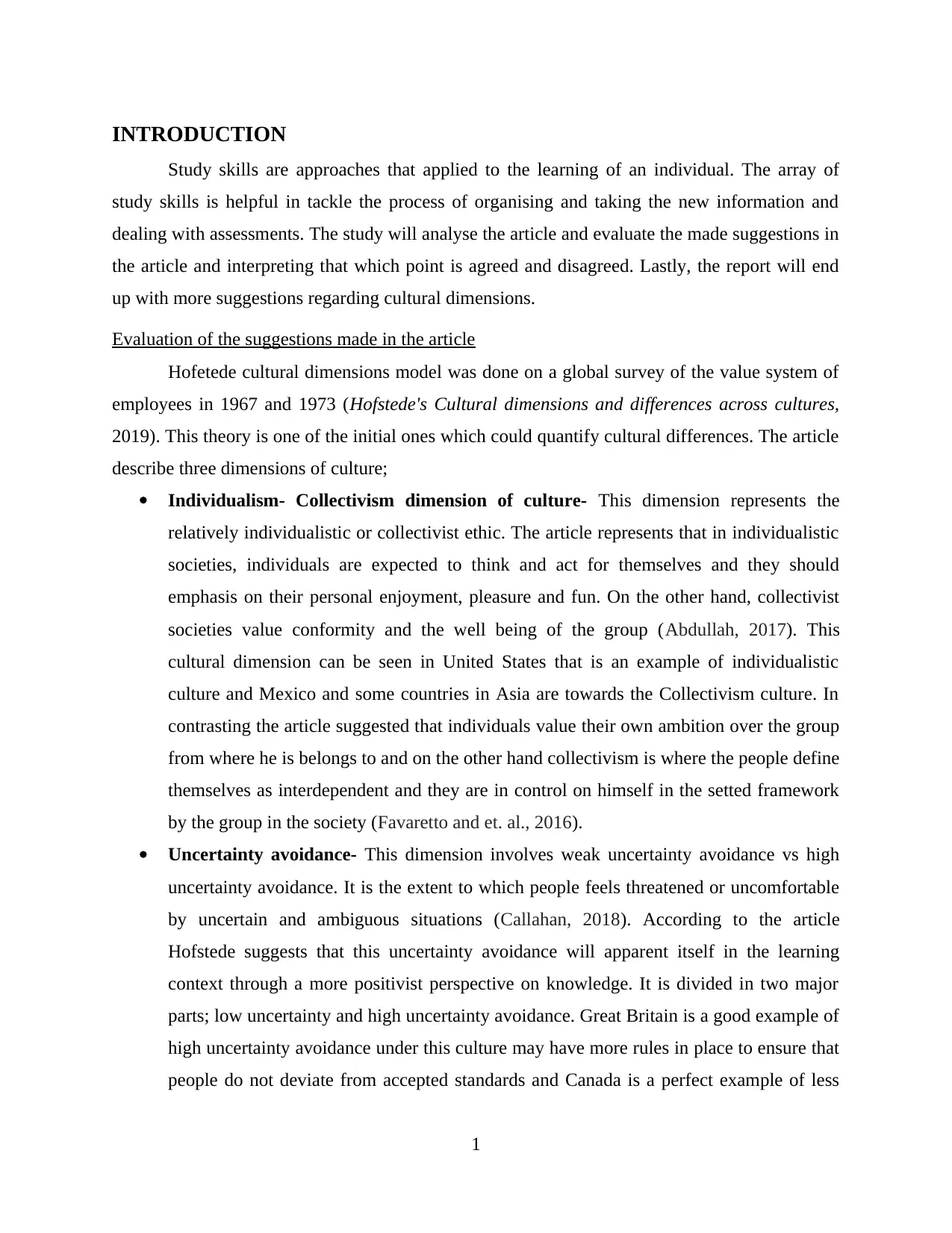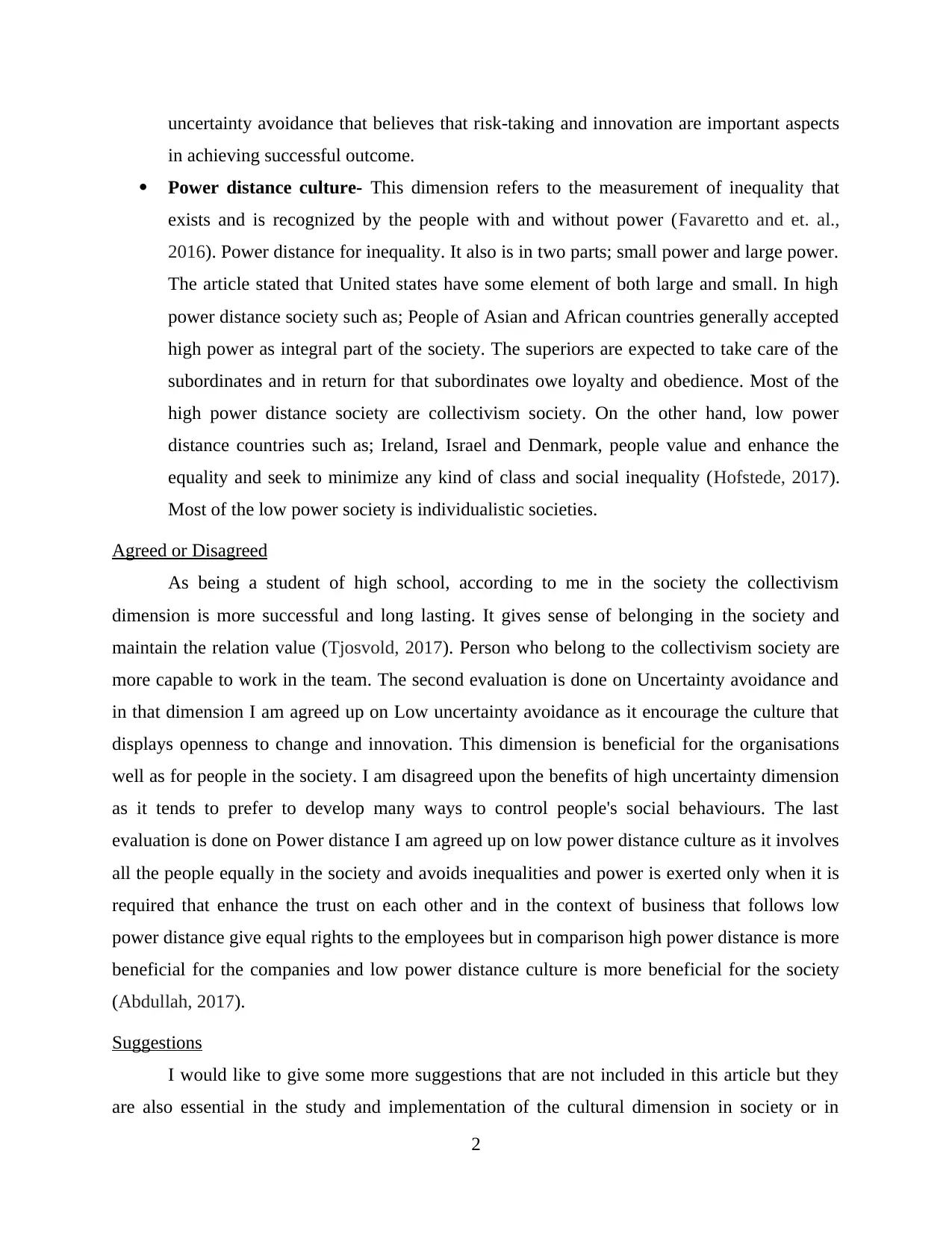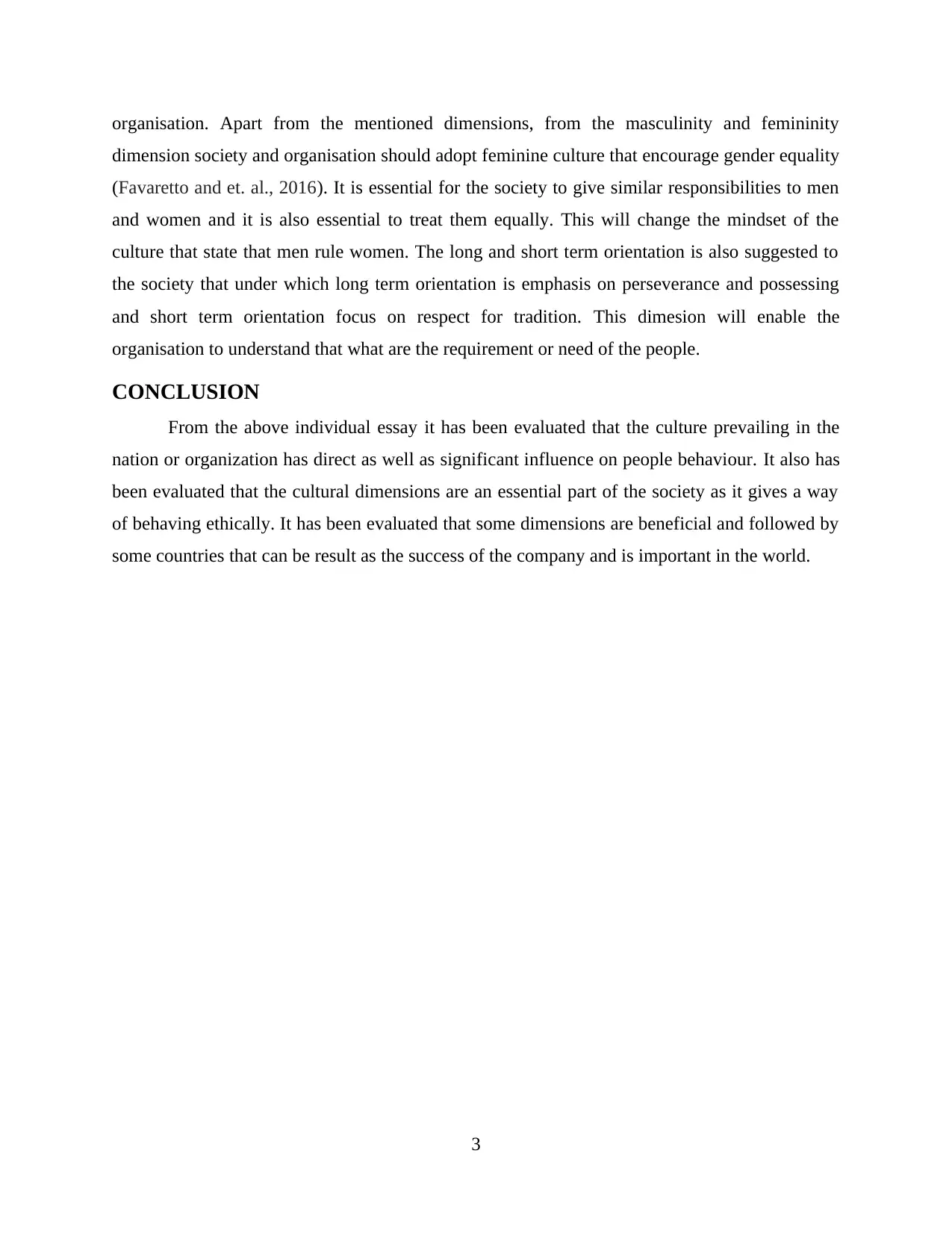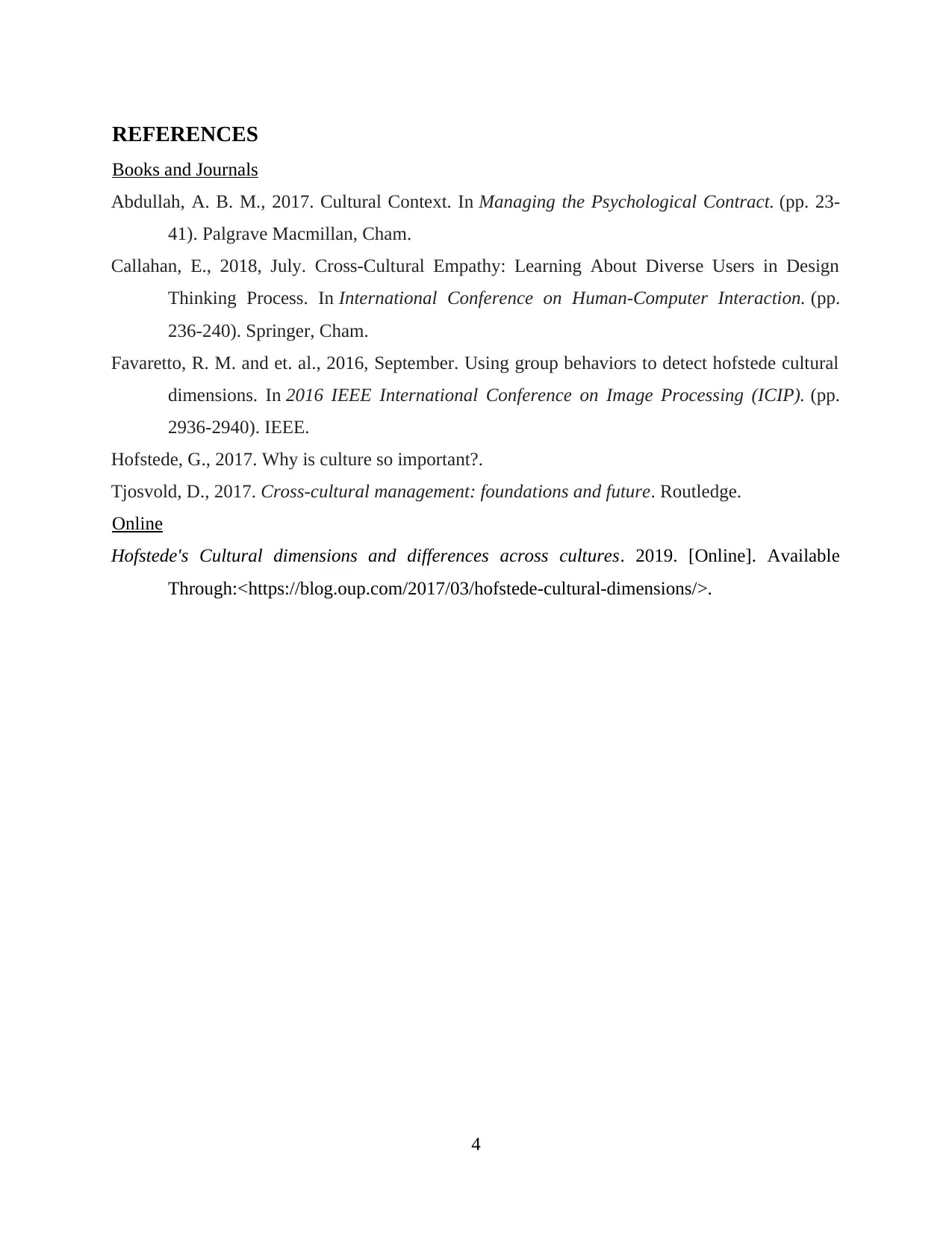Study Skills Essay: Evaluating Hofstede's Cultural Dimensions
VerifiedAdded on 2020/11/23
|6
|1270
|54
Essay
AI Summary
This essay examines the influence of cultural dimensions on study skills, focusing on Hofstede's model. It evaluates the dimensions of individualism-collectivism, uncertainty avoidance, and power distance, discussing their implications in learning environments. The essay analyzes the suggestions made in an article, expressing agreement or disagreement with the viewpoints presented. Furthermore, it offers additional suggestions, such as incorporating masculinity-femininity and long-term/short-term orientation dimensions. The conclusion emphasizes the significant impact of cultural dimensions on individual behavior and the importance of these dimensions for societal and organizational success.

Study skills
Paraphrase This Document
Need a fresh take? Get an instant paraphrase of this document with our AI Paraphraser

Table of Contents
INTRODUCTION...........................................................................................................................1
Evaluation of the suggestions made in the article.......................................................................1
Agreed or Disagreed...................................................................................................................2
Suggestions.................................................................................................................................2
Conclusion.......................................................................................................................................3
REFERENCES................................................................................................................................4
INTRODUCTION...........................................................................................................................1
Evaluation of the suggestions made in the article.......................................................................1
Agreed or Disagreed...................................................................................................................2
Suggestions.................................................................................................................................2
Conclusion.......................................................................................................................................3
REFERENCES................................................................................................................................4

INTRODUCTION
Study skills are approaches that applied to the learning of an individual. The array of
study skills is helpful in tackle the process of organising and taking the new information and
dealing with assessments. The study will analyse the article and evaluate the made suggestions in
the article and interpreting that which point is agreed and disagreed. Lastly, the report will end
up with more suggestions regarding cultural dimensions.
Evaluation of the suggestions made in the article
Hofetede cultural dimensions model was done on a global survey of the value system of
employees in 1967 and 1973 (Hofstede's Cultural dimensions and differences across cultures,
2019). This theory is one of the initial ones which could quantify cultural differences. The article
describe three dimensions of culture;
Individualism- Collectivism dimension of culture- This dimension represents the
relatively individualistic or collectivist ethic. The article represents that in individualistic
societies, individuals are expected to think and act for themselves and they should
emphasis on their personal enjoyment, pleasure and fun. On the other hand, collectivist
societies value conformity and the well being of the group (Abdullah, 2017). This
cultural dimension can be seen in United States that is an example of individualistic
culture and Mexico and some countries in Asia are towards the Collectivism culture. In
contrasting the article suggested that individuals value their own ambition over the group
from where he is belongs to and on the other hand collectivism is where the people define
themselves as interdependent and they are in control on himself in the setted framework
by the group in the society (Favaretto and et. al., 2016).
Uncertainty avoidance- This dimension involves weak uncertainty avoidance vs high
uncertainty avoidance. It is the extent to which people feels threatened or uncomfortable
by uncertain and ambiguous situations (Callahan, 2018). According to the article
Hofstede suggests that this uncertainty avoidance will apparent itself in the learning
context through a more positivist perspective on knowledge. It is divided in two major
parts; low uncertainty and high uncertainty avoidance. Great Britain is a good example of
high uncertainty avoidance under this culture may have more rules in place to ensure that
people do not deviate from accepted standards and Canada is a perfect example of less
1
Study skills are approaches that applied to the learning of an individual. The array of
study skills is helpful in tackle the process of organising and taking the new information and
dealing with assessments. The study will analyse the article and evaluate the made suggestions in
the article and interpreting that which point is agreed and disagreed. Lastly, the report will end
up with more suggestions regarding cultural dimensions.
Evaluation of the suggestions made in the article
Hofetede cultural dimensions model was done on a global survey of the value system of
employees in 1967 and 1973 (Hofstede's Cultural dimensions and differences across cultures,
2019). This theory is one of the initial ones which could quantify cultural differences. The article
describe three dimensions of culture;
Individualism- Collectivism dimension of culture- This dimension represents the
relatively individualistic or collectivist ethic. The article represents that in individualistic
societies, individuals are expected to think and act for themselves and they should
emphasis on their personal enjoyment, pleasure and fun. On the other hand, collectivist
societies value conformity and the well being of the group (Abdullah, 2017). This
cultural dimension can be seen in United States that is an example of individualistic
culture and Mexico and some countries in Asia are towards the Collectivism culture. In
contrasting the article suggested that individuals value their own ambition over the group
from where he is belongs to and on the other hand collectivism is where the people define
themselves as interdependent and they are in control on himself in the setted framework
by the group in the society (Favaretto and et. al., 2016).
Uncertainty avoidance- This dimension involves weak uncertainty avoidance vs high
uncertainty avoidance. It is the extent to which people feels threatened or uncomfortable
by uncertain and ambiguous situations (Callahan, 2018). According to the article
Hofstede suggests that this uncertainty avoidance will apparent itself in the learning
context through a more positivist perspective on knowledge. It is divided in two major
parts; low uncertainty and high uncertainty avoidance. Great Britain is a good example of
high uncertainty avoidance under this culture may have more rules in place to ensure that
people do not deviate from accepted standards and Canada is a perfect example of less
1
⊘ This is a preview!⊘
Do you want full access?
Subscribe today to unlock all pages.

Trusted by 1+ million students worldwide

uncertainty avoidance that believes that risk-taking and innovation are important aspects
in achieving successful outcome.
Power distance culture- This dimension refers to the measurement of inequality that
exists and is recognized by the people with and without power (Favaretto and et. al.,
2016). Power distance for inequality. It also is in two parts; small power and large power.
The article stated that United states have some element of both large and small. In high
power distance society such as; People of Asian and African countries generally accepted
high power as integral part of the society. The superiors are expected to take care of the
subordinates and in return for that subordinates owe loyalty and obedience. Most of the
high power distance society are collectivism society. On the other hand, low power
distance countries such as; Ireland, Israel and Denmark, people value and enhance the
equality and seek to minimize any kind of class and social inequality (Hofstede, 2017).
Most of the low power society is individualistic societies.
Agreed or Disagreed
As being a student of high school, according to me in the society the collectivism
dimension is more successful and long lasting. It gives sense of belonging in the society and
maintain the relation value (Tjosvold, 2017). Person who belong to the collectivism society are
more capable to work in the team. The second evaluation is done on Uncertainty avoidance and
in that dimension I am agreed up on Low uncertainty avoidance as it encourage the culture that
displays openness to change and innovation. This dimension is beneficial for the organisations
well as for people in the society. I am disagreed upon the benefits of high uncertainty dimension
as it tends to prefer to develop many ways to control people's social behaviours. The last
evaluation is done on Power distance I am agreed up on low power distance culture as it involves
all the people equally in the society and avoids inequalities and power is exerted only when it is
required that enhance the trust on each other and in the context of business that follows low
power distance give equal rights to the employees but in comparison high power distance is more
beneficial for the companies and low power distance culture is more beneficial for the society
(Abdullah, 2017).
Suggestions
I would like to give some more suggestions that are not included in this article but they
are also essential in the study and implementation of the cultural dimension in society or in
2
in achieving successful outcome.
Power distance culture- This dimension refers to the measurement of inequality that
exists and is recognized by the people with and without power (Favaretto and et. al.,
2016). Power distance for inequality. It also is in two parts; small power and large power.
The article stated that United states have some element of both large and small. In high
power distance society such as; People of Asian and African countries generally accepted
high power as integral part of the society. The superiors are expected to take care of the
subordinates and in return for that subordinates owe loyalty and obedience. Most of the
high power distance society are collectivism society. On the other hand, low power
distance countries such as; Ireland, Israel and Denmark, people value and enhance the
equality and seek to minimize any kind of class and social inequality (Hofstede, 2017).
Most of the low power society is individualistic societies.
Agreed or Disagreed
As being a student of high school, according to me in the society the collectivism
dimension is more successful and long lasting. It gives sense of belonging in the society and
maintain the relation value (Tjosvold, 2017). Person who belong to the collectivism society are
more capable to work in the team. The second evaluation is done on Uncertainty avoidance and
in that dimension I am agreed up on Low uncertainty avoidance as it encourage the culture that
displays openness to change and innovation. This dimension is beneficial for the organisations
well as for people in the society. I am disagreed upon the benefits of high uncertainty dimension
as it tends to prefer to develop many ways to control people's social behaviours. The last
evaluation is done on Power distance I am agreed up on low power distance culture as it involves
all the people equally in the society and avoids inequalities and power is exerted only when it is
required that enhance the trust on each other and in the context of business that follows low
power distance give equal rights to the employees but in comparison high power distance is more
beneficial for the companies and low power distance culture is more beneficial for the society
(Abdullah, 2017).
Suggestions
I would like to give some more suggestions that are not included in this article but they
are also essential in the study and implementation of the cultural dimension in society or in
2
Paraphrase This Document
Need a fresh take? Get an instant paraphrase of this document with our AI Paraphraser

organisation. Apart from the mentioned dimensions, from the masculinity and femininity
dimension society and organisation should adopt feminine culture that encourage gender equality
(Favaretto and et. al., 2016). It is essential for the society to give similar responsibilities to men
and women and it is also essential to treat them equally. This will change the mindset of the
culture that state that men rule women. The long and short term orientation is also suggested to
the society that under which long term orientation is emphasis on perseverance and possessing
and short term orientation focus on respect for tradition. This dimesion will enable the
organisation to understand that what are the requirement or need of the people.
CONCLUSION
From the above individual essay it has been evaluated that the culture prevailing in the
nation or organization has direct as well as significant influence on people behaviour. It also has
been evaluated that the cultural dimensions are an essential part of the society as it gives a way
of behaving ethically. It has been evaluated that some dimensions are beneficial and followed by
some countries that can be result as the success of the company and is important in the world.
3
dimension society and organisation should adopt feminine culture that encourage gender equality
(Favaretto and et. al., 2016). It is essential for the society to give similar responsibilities to men
and women and it is also essential to treat them equally. This will change the mindset of the
culture that state that men rule women. The long and short term orientation is also suggested to
the society that under which long term orientation is emphasis on perseverance and possessing
and short term orientation focus on respect for tradition. This dimesion will enable the
organisation to understand that what are the requirement or need of the people.
CONCLUSION
From the above individual essay it has been evaluated that the culture prevailing in the
nation or organization has direct as well as significant influence on people behaviour. It also has
been evaluated that the cultural dimensions are an essential part of the society as it gives a way
of behaving ethically. It has been evaluated that some dimensions are beneficial and followed by
some countries that can be result as the success of the company and is important in the world.
3

REFERENCES
Books and Journals
Abdullah, A. B. M., 2017. Cultural Context. In Managing the Psychological Contract. (pp. 23-
41). Palgrave Macmillan, Cham.
Callahan, E., 2018, July. Cross-Cultural Empathy: Learning About Diverse Users in Design
Thinking Process. In International Conference on Human-Computer Interaction. (pp.
236-240). Springer, Cham.
Favaretto, R. M. and et. al., 2016, September. Using group behaviors to detect hofstede cultural
dimensions. In 2016 IEEE International Conference on Image Processing (ICIP). (pp.
2936-2940). IEEE.
Hofstede, G., 2017. Why is culture so important?.
Tjosvold, D., 2017. Cross-cultural management: foundations and future. Routledge.
Online
Hofstede's Cultural dimensions and differences across cultures. 2019. [Online]. Available
Through:<https://blog.oup.com/2017/03/hofstede-cultural-dimensions/>.
4
Books and Journals
Abdullah, A. B. M., 2017. Cultural Context. In Managing the Psychological Contract. (pp. 23-
41). Palgrave Macmillan, Cham.
Callahan, E., 2018, July. Cross-Cultural Empathy: Learning About Diverse Users in Design
Thinking Process. In International Conference on Human-Computer Interaction. (pp.
236-240). Springer, Cham.
Favaretto, R. M. and et. al., 2016, September. Using group behaviors to detect hofstede cultural
dimensions. In 2016 IEEE International Conference on Image Processing (ICIP). (pp.
2936-2940). IEEE.
Hofstede, G., 2017. Why is culture so important?.
Tjosvold, D., 2017. Cross-cultural management: foundations and future. Routledge.
Online
Hofstede's Cultural dimensions and differences across cultures. 2019. [Online]. Available
Through:<https://blog.oup.com/2017/03/hofstede-cultural-dimensions/>.
4
⊘ This is a preview!⊘
Do you want full access?
Subscribe today to unlock all pages.

Trusted by 1+ million students worldwide
1 out of 6
Related Documents
Your All-in-One AI-Powered Toolkit for Academic Success.
+13062052269
info@desklib.com
Available 24*7 on WhatsApp / Email
![[object Object]](/_next/static/media/star-bottom.7253800d.svg)
Unlock your academic potential
Copyright © 2020–2025 A2Z Services. All Rights Reserved. Developed and managed by ZUCOL.


